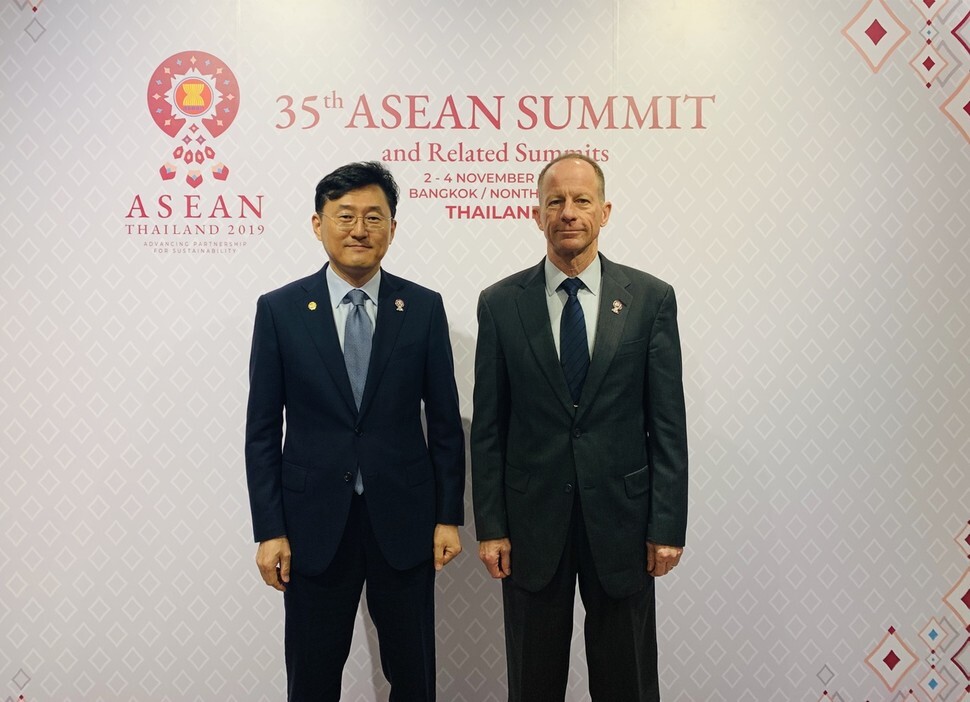hankyoreh
Links to other country sites 다른 나라 사이트 링크
S. Korea, US, release “joint fact sheet” on New Southern Policy and Indo-Pacific Strategy

On Nov. 2, the South Korean and American governments disclosed a “joint fact sheet” that summarizes efforts in several areas aimed at improving cooperation between South Korea’s New Southern Policy and the US’ Indo-Pacific Strategy. A joint explanatory document released by South Korea’s Ministry of Foreign Affairs and the US’ State Department arranges various types of cooperation into the three overarching categories of prosperity (including energy, infrastructure, development loans, and the digital economy), people (good governance and civic society), and peace (cooperation on water management in the Mekong region and responding to climate change for island nations in the Pacific Ocean). However, the explanatory document doesn’t contain any information about security cooperation in the traditional sense, including military affairs.
This document is thought to represent a compromise between the two countries and their conflicting goals. The US has been attempting to incorporate South Korea into its Indo-Pacific Strategy, which is designed to contain China, while South Korea has sought to avoid getting “entangled” in the US’ containment network.
South Korean Deputy Foreign Minister Yoon Soon-gu and US Assistant Secretary of State for East Asian and Pacific Affairs David Stilwell held bilateral deliberations in Bangkok, Thailand, during the ASEAN summit on Nov. 2. “We agreed to work together on building a safe, prosperous, and dynamic future for the Indo-Pacific region through cooperation based on the principles of openness, inclusivity, transparency, respect under international norms, and the centrality of ASEAN,” South Korea’s Foreign Ministry announced.
S. Korea declines to take sides between Belt and Road Initiative and Indo-Pacific StrategyFor a while, the South Korean government had declined to adopt an official stance on whether it would participate in China’s Belt and Road Initiative or in the US’ Indo-Pacific Strategy. Then during a South Korea-US summit on June 30, Seoul announced for the first time that it would “pursue harmonious compromise between the New Southern Policy and the Indo-Pacific Strategy.”
The next step was the two countries’ release of this joint explanatory document. Kim Jeong, a professor at the University of North Korean Studies, said on Nov. 3 that the document “appears to show the maximum extent to which South Korea is able to accept the American demands.”
“In light of the US-China relationship, the US’ demand for support of its policy of ‘freedom of navigation’ [in a US-led South China Sea] is probably the hardest thing for South Korea to swallow, and [in this document], at least, it was left out,” said Lee Hye-jeong, a professor at Chung-Ang University.
“If the agreement concerns active prevention and disposal of threats, ‘overlapping’ participation in the Indo-Pacific Strategy and the Belt and Road Initiative would be possible,” Lee Hye-jeong said.
“While the US is urging South Korea to participate in its Indo-Pacific Strategy, South Korea can’t help but defer to China, which is rapidly emerging as the hegemonic state in East Asia. Rather than viewing this as an either-or choice, Seoul is attempting to link both of those plans with its New Southern Policy and its New Northern Policy,” said a high-ranking official at a state-funded research institute. In fact, the South Korean government is looking into the option of participating in both of the two countries’ regional plans as opposed to opting exclusively for one or the other.
When Stilwell visits South Korea on Nov. 5, this is expected to be one of the various pressing issues that he‘ll be discussing with South Korean officials, along with the South Korea-Japan dispute and the scheduled termination of their GSOMIA intelligence-sharing agreement.
By Noh Ji-won, staff reporter
Please direct comments or questions to [english@hani.co.kr]

Editorial・opinion
![[Guest essay] Preventing Korean Peninsula from becoming front line of new cold war [Guest essay] Preventing Korean Peninsula from becoming front line of new cold war](https://flexible.img.hani.co.kr/flexible/normal/500/300/imgdb/original/2024/0507/7217150679227807.jpg) [Guest essay] Preventing Korean Peninsula from becoming front line of new cold war
[Guest essay] Preventing Korean Peninsula from becoming front line of new cold war![[Column] The state is back — but is it in business? [Column] The state is back — but is it in business?](https://flexible.img.hani.co.kr/flexible/normal/500/300/imgdb/original/2024/0506/8217149564092725.jpg) [Column] The state is back — but is it in business?
[Column] The state is back — but is it in business?- [Column] Life on our Trisolaris
- [Editorial] Penalties for airing allegations against Korea’s first lady endanger free press
- [Editorial] Yoon must halt procurement of SM-3 interceptor missiles
- [Guest essay] Maybe Korea’s rapid population decline is an opportunity, not a crisis
- [Column] Can Yoon steer diplomacy with Russia, China back on track?
- [Column] Season 2 of special prosecutor probe may be coming to Korea soon
- [Column] Park Geun-hye déjà vu in Yoon Suk-yeol
- [Editorial] New weight of N. Korea’s nuclear threats makes dialogue all the more urgent
Most viewed articles
- 1[Guest essay] Preventing Korean Peninsula from becoming front line of new cold war
- 2Yoon’s broken-compass diplomacy is steering Korea into serving US, Japanese interests
- 360% of young Koreans see no need to have kids after marriage
- 4After 2 years in office, Yoon’s promises of fairness, common sense ring hollow
- 5[Column] Why Korea’s hard right is fated to lose
- 6S. Korean first lady likely to face questioning by prosecutors over Dior handbag scandal
- 7[News analysis] Jo Song-gil’s defection and its potential impact on inter-Korean relations
- 8[Column] “Hoesik” as ritual of hierarchical obedience
- 9Amid US-China clash, Korea must remember its failures in the 19th century, advises scholar
- 1011 years after US decamped, military base in Busan still festering with pollution